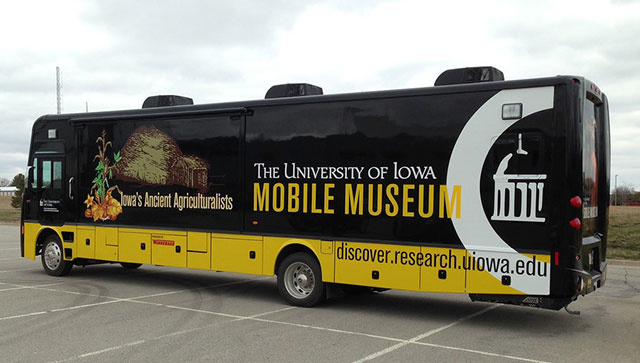Thousands of visitors come to the University of Iowa each year to visit Rusty the Giant Sloth, learn about the state’s first capitol, and see how Iowa’s landscape has changed over the centuries.
Starting this week, the UI Pentacrest Museums (the Old Capitol Museum and the Museum of Natural History) and Office of the State Archaeologist are bringing some of the state’s natural and cultural treasures to Iowa communities in a new Mobile Museum.
To see a related story, visit, UI Mobile Museum to bring the Ice Age to Fort Dodge.
The 38-foot-long RV—custom built by Winnebago Industries in Forest City—makes its inaugural appearance next weekend at Iowa Central Community College in Fort Dodge for the Iowa Academy of Science meeting April 11-12 before heading to Decorah, Osage, and Council Bluffs, to name a few of the scheduled destinations.
The Mobile Museum features an array of exhibits that focus on three very different eras in Iowa’s history:
- Iowa’s Ice Age Giants explores the great mammals that roamed that state during the last ice age and their sudden extinction.
- Glenwood: Iowa’s Ancient Agriculturalists tells the story of the Glenwood culture centered in the Loess Hills and their connections to the Iowa landscape through agriculture.
- Cornerstones focuses on the founding of Iowa and writing of its constitution, the building of the Old Capitol building, and the creation of the UI.
The museum also features a new digital wall that allows visitors to learn about—and interact with—modules about UI space research, the Santos Virtual Soldier program, and the UI Flood Center’s sophisticated flood-prediction mapping systems, as well as additional information on Iowa archaeology.
“This is a museum built in Iowa, by Iowans, for Iowans,” says Dan Reed, vice president for research and economic development, whose office includes the Pentacrest Museums and State Archaeologist.

In addition to the work by Winnebago Industries, the Mobile Museum’s exhibits were designed and installed by Hiawatha-based Presentations and Iowa City’s Armadillo Arts. Benson & Hepker Design, also of Iowa City, designed the graphics on the vehicle’s exterior.
Reed says the Mobile Museum is part of a broader goal to cultivate new, more active partnerships across the state, helping individuals, businesses, communities, and government be successful. He says he’s committed to sharing the assets of the university with all the citizens of Iowa.
“From my own experience growing up in rural Arkansas, I can attest to the importance of exposing young minds to creative programs,” Reed says. “It was a science outreach program that first ignited my passion for science and technology. We hope to generate that same kind of excitement for science in people—young and older—across Iowa.”
While the Mobile Museum’s schedule is still being finalized, officials say they plan to visit schools and libraries as well as have a presence at special events across the state, such as a national rally at Winnebago headquarters in Forest City and several stops along the RAGBRAI route, where the Office of the State Archaeologist has long had a strong educational presence.
Shalla Ashworth, associate director of the Old Capitol Museum, says she hopes visitors to the Mobile Museum will have an “Aha!” moment as they learn about the state’s rich history and the UI’s work toward building understanding of the world, from deep under the earth to the outer reaches of space.
“We should be proud that we have world-class research programs, including a space program that has contributed so much to our understanding of the universe,” she says.
Trina Roberts, associate director of the UI Museum of Natural History, says the Mobile Museum provides Iowans with a window into their collective past and into the university’s research and creative work.
“We’ve have had so much support from communities throughout the state already through smaller education and outreach programs, and we’re looking forward to expanding those partnerships and creating new ones through the Mobile Museum,” Roberts says.
State Archaeologist John Doershuk says he’s excited for his office’s partnership with the project and says the Mobile Museum “significantly increases our ability to interact with Iowans on a statewide basis about important issues like why the past matters today. Understanding the past helps us appreciate the world—socially and physically—in the present. Fundamentally, it's a quality of life issue: if you want to prepare for the future you need to understand the past.”
Doershuk adds, “Museums are places for conversation, learning, and sharing knowledge. The Mobile Museum provides us a statewide opportunity to broadly share some of the results UI research. This makes perfect sense as Iowans support our research so they should hear and see about it, too.”
For more information about the Mobile Museum, or to inquire about its availability, visit discover.research.uiowa.edu or email mobile-museum@uiowa.edu.
Casey Westlake with UI Pentacrest Museums contributed to this article.
News Editors: A media availability and tour of the Mobile Museum will be held from 3-5 p.m. Tuesday, April 8, in the BioVentures Center parking lot in the University of Iowa Research Park, 2500 Crosspark Road, Coralville. Media planning to attending should contact University News Services Director Stephen Pradarelli at 319-384-0007 or stephen-pradarelli@uiowa.edu. Photos of the Mobile Museum are available at www.flickr.com/photos/uinews/sets/72157643306380623/.